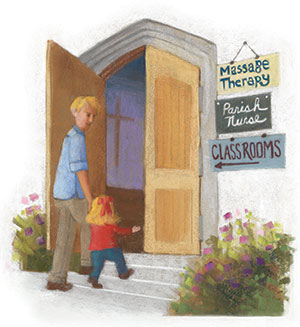Seven years ago, the softball team manager of Woodlake Lutheran Church in Richfield, Minn., faced a challenge.
While the congregation once boasted a strong team, declining membership no longer made it feasible to be a softball powerhouse, or any force at all, in the Richfield Church League. In fact, the league itself was in danger of disbanding due to a lack of teams.
To continue playing softball, Scott Dahlquist did what any team manager would do — he scouted out new talent. “I sent a letter to all the churches in the area that didn’t have teams,” he said.
In the end, two other Richfield congregations joined Woodlake: Oak Grove Lutheran Church and St. Richard’s Roman Catholic Church.

Eventually the team, known as the Woodgrove Saints, joined the neighboring Bloomington (Minn.) Church/Spiritual League when the Richfield league disbanded. Dahlquist and 18 other players now bat for the Saints, whose success on the field may not always reflect their success at inter-congregational collaboration.
When asked about their record, demonstrating both grace and good sports etiquette, Dahlquist offered an ESPN-worthy response: “I’m just happy to have the opportunity to play.”
Although the Saints finished their season in June, the cooperative spirit continues off the field. A community interfaith emergency housing project that Dahlquist helps coordinate relies on support from several congregations.
No single congregation can do it alone. “If we’re going to sustain our involvement in this program, the way forward is to do that as a collaborative effort with some other congregations,” Dahlquist said.
It’s no secret that ELCA congregations are leaner now. As of 2013 more than a third of all congregations — 3,251 of them — had an average worship attendance of 50 or fewer. In 2000 only
20 percent of the congregations had an average worship attendance of fewer than 50.
According to data compiled by ELCA Research and Evaluation, 82 percent of ELCA congregations declined by 5 percent or more in average worship attendance between 2000 and 2013, with 7 percent experiencing stable attendance (they lost or gained fewer than 5 percent) and 11 percent gaining more than 5 percent.
All of which means: If you’re an ELCA member, chances are good your congregation is learning to do ministry with fewer people in the pews. Regardless of whether that means fewer folks for church softball, diminishing worship resources or fewer members involved in social ministry, congregational ministry has inevitably changed.

‘Small can be beautiful’
When Beverly Piro, interim pastor of St. Andrew Lutheran, Arvada, Colo., started her position in November 2013, she found a “pretty deflated” congregation.
“They were asking themselves, ‘Are we going to be able to continue?’ ” With only 50 people in worship each Sunday, the congregation was “wallowing in grief” about their smaller size and not being able to do ministry as they once could, such as sustain a Sunday school.
Last summer, Piro helped the congregation launch a discernment process, taking stock of their strengths and assets. Through this process, members noted that their building, fully paid off, was an underused asset. Without a viable Sunday school, the eight-room education wing was being used only for storage.
But an inefficient use of space wasn’t the heart of the problem, Piro said. Without any purpose, these rooms served as a visible “reminder of who they had been,” she added. “It was abandoned and it felt awful.”
Through a serendipitous conversation with a member, Piro and the congregational council began to research the possibility of renting space to a mental health counseling office and then to a massage therapist. Council members had to work through their concerns about the impact of charging rent on the congregation’s tax exempt status, but legal advice helped them understand how to make it work.
In October 2014, on the day the Christian church honors physician/evangelist Luke, the “St. Andrew Lutheran Church Healing Arts Center” was dedicated.
“It’s been remarkable,” said Piro, noting a change in the congregation’s spirit and vitality.
The congregation used to lock the sanctuary during the day, but now the doors are always open, inviting guests inside. A healing arts fair introduced visitors to the building, strengthening the congregation’s community presence. The tenants are also doing well, with one business expanding into a second office space at the church.
The congregation’s renewed focus has made a difference. There’s a “really good spirit here now and people are noticing” — and visitors are starting to show up at worship, Piro said.
Congregational growth, however, was never the point, she said. St. Andrew now has a presence and role in the community.
“[Members] are seeing themselves as … a hub of activity that extends outside of Sunday morning. … It’s like we’re walking out of the catacombs of death into life,” Piro said.
Small congregations like St. Andrew can still have a big impact on their community, said Stephen P. Bouman, executive director for ELCA Congregational and Synodical Mission. But they will likely need to engage with their community and seek out partnerships and collaborations, building from an appreciation of their collective assets and not a focus on their deficits.
“In the way of Jesus, small can be beautiful,” Bouman said. “[Congregations of any size can] hunker down and make a difference in the lives of their community and lives of their members. Usually when you come to that identity, you start to grow in spite of yourselves.”

Growing beans, not members
Gloria Dei Lutheran Church, Mulberry, Ind., is home to Katie’s Commons, an ecumenical community garden and the brainchild of its pastor, Michael Crawford.
While explicitly designed to be a community enterprise and not a ministry of Gloria Dei, the congregation hosts the garden and provides space and water. Average weekly worship attendance at the church is about 40.
The primary gardeners are from Gloria Dei, the local Methodist congregation and a nondenominational community church. Katie’s Commons raises produce for area food pantries. Crawford and garden leaders initially approached food pantry consumers to ask what fresh produce they would like. In the 2014 growing season, they raised lettuces, tomatoes, cantaloupes and a bumper crop of green beans.
The purpose of this garden, Crawford said, is not to increase membership or worship attendance in any of the participating congregations but to truly engage in the community using one of Gloria Dei’s assets, its property on the edge of town. Looking to the future, Crawford sees this as an important role for the congregation, even if quantitative growth isn’t on the horizon.
“Our congregation will be that smaller community, living out Christian values as a witness to the larger community,” Crawford said. “I think people will join our work but maybe not our worship. God works well with remnants and perhaps we’ll be that remnant in Clinton County, Ind., and I think the gospel will be spread.”
Same hymns, new music
Like many congregations, Holy Trinity Lutheran’s context is tied closely to that of its community, Martinsville, Va. Once known for a textile industry and furniture manufacturing, Martinsville experienced financial challenges beginning in the early 1990s when factories shut down and jobs moved away. Since then, said Lynn Bechdolt, Holy Trinity’s former pastor, most congregations in the area have struggled with declining membership.
Holy Trinity now has fewer than 60 members, with an average worship attendance of 26. Because of the low numbers, Bechdolt had to resign her position, effective in June.
Despite declining membership and finances, Holy Trinity has continued to exist through creativity and ingenuity.
Following the sale of unused property, the congregation invested in energy-saving upgrades, including more efficient windows and a conversion to natural gas for heating. These upgrades resulted in lower electric and fuel bills, providing more long-term savings.
The biggest change came five years ago when Holy Trinity could no longer afford to pay for a worship musician. Funding the position was only part of the challenge. The congregation also needed to find a musician who understood liturgical worship in this non-Lutheran part of Virginia.
Necessity being the mother of invention, Bechdolt took on the challenge of finding an alternative. After some trial and error, she incorporated prerecorded music into worship, connecting the sound system into the speakers for the congregation’s electronic organ. Bechdolt discovered an organist in Australia who operates a website (www.smallchurchmusic.weebly.com) that congregations can use to purchase worship music, either at no cost for hymns without copyright or for a small fee for those with copyright protection.
When a particular hymn wasn’t available, Bechdolt learned how to record her own accompaniment using a digital audio workshop, modifying the music as needed.
“If the congregation doesn’t do well with it,” Bechdolt said, “then I have to go in and redo it. We’re a singing church, we sing everything. Until I did this, I didn’t realize how much we sing.”
The congregation has done well with this approach, and Bechdolt shared this strategy with other congregations in similar situations. While it’s not a perfect solution, she believes prerecorded music may still be a better approach in some situations, particularly in those congregations that can’t afford or don’t have access to a skilled worship musician.
“There’s no reason why you can’t have a hybrid,” she said. “You use an organist for what they can do, but you use recorded music for the things they can’t play.”
Holy Trinity has had to get used to worshiping without an organist, and that can be a challenge, Bechdolt acknowledged. “When we sing with a musician … they are hearing us and gauging how they’re playing with us,” she said. “One of the things we learned early on is that we had to play [prerecorded music] loud. If we’re not playing loud enough, some people in the back like to take off and sing their own thing, and then they’re two bars behind and taking the congregation with them.”
On the other hand, the benefit far outweighs the challenge, Bechdolt said, adding, “We still have lively worship, and that’s the main thing.”
Now in a pastoral vacancy, Holy Trinity will continue to face challenges. As the only ELCA church in three counties, with the nearest one 35 minutes away, Bechdolt believes ecumenical partnerships may be integral to the congregation’s future.
Regardless of what the future holds, the congregation doesn’t need to rely on the presence of a church musician or even Bechdolt to continue their new worship music tradition. Before leaving, she passed along her newly developed computer music knowledge to congregational leaders: “I’m teaching them to do that now. I’m going to make it easy for them to do their own liturgy.”
Doing more with more
Congregational collaborations, with other ELCA congregations or as ecumenical partnerships, can be the key to renewing ministry and mission, Bouman said. “That’s what we’re seeing all over the church where congregations are banding together, doing ministry that they can’t do alone,” he said.
Area mission strategies, a strategic discernment process for initiating these congregational collaborations, can renew a sense of ministry and mission in churches with declining membership numbers.
“Area mission strategies can be driven by small congregations … that want to throw their lot in with each other,” said Bouman, who encourages church members to center their strategies on listening to God and their community. “Listen to your community and you become relevant,” he said.
This strategy is at work in the Indiana-Kentucky Synod. Congregations coping with the impact of a declining membership undergo a “change of culture” said Nancy Nyland, the synod’s director for evangelical mission. “There’s a sense that if they can’t sustain a full-time pastor, for example, they’ve failed. The synod is helping them work through their grief” and then move into a new context for mission and ministry.
In the synod’s “Area Mission Conversations,” Nyland works with two to seven congregations in one area for a process focused on identifying assets and asking discernment questions, such as “What can we do together that we can’t do alone?” and “How can we be a stronger Lutheran presence in this community?”
One such conversation began in Elkhart. The northern Indiana city was hit hard by the recession in 2009, at one point experiencing as high as 25 percent unemployment. This inevitably impacted congregational membership and finances. Four ELCA congregations — three in Elkhart (Augustana, Grace and Redeemer) and Zion in nearby Bristol — began meeting together in 2013 to talk about ways to collaborate. The four congregations each have average weekly worship attendance of between 50 and 110 people.
Collaboration wasn’t about ignoring differences, said Daniel F. Forehand, pastor of Grace. The four congregations “have different styles of worship and different cultures,” but they’ve found common ground in the “desire that this city needs to hear the gospel,” he said.
The congregations joined together to share confirmation and coordinate social ministry programs. They planned a joint worship service this summer and are working on a combined Reformation observation this fall. The four congregations also are looking forward to a joint Habitat for Humanity service project in the spring of 2016.
The collaboration is “about the radical love of Jesus breaking into neighborhoods,” Forehand said. “We do that far better together than separate.”
With more than 80 percent of ELCA congregations experiencing a decline in worship attendance, collaboration and creativity may be the key to moving forward for any size congregation.
But not all collaborative ventures may be successful, at least by conventional measures. Just ask the Woodgrove Saints. Their first game ended in a heartbreaking 16-17 loss against the Presbyterians. Quipped manager Dahlquist: “It’s an excellent chance to practice humility.”
As for the rest of the season, grace abounds — on the softball field and throughout the mission field. Or in other words, there’s always next year.
By the numbers
Demographics compiled by ELCA Research and Evaluation indicate that the denomination’s congregations are getting smaller.
From 1990 to 2013, the number of congregations with an average worship attendance of 50 or fewer increased by 66 percent. At the same time, the number of congregations with more than a 350 average worship attendance decreased by 50 percent.
In 2013 (the most recent year of data available), more than half of all ELCA congregations had an average worship attendance of 75 or fewer members, compared to 36 percent in 2000 and 32 percent in 1990.
If you’re in a small congregation, chances are your church is getting smaller. For congregations with 50 or fewer worship attendees in 2013, 87 percent declined 5 percent or more in worship attendance between 2000 and 2013. Only 7 percent of those smaller congregations grew by 5 percent or more in worship attendance.
By contrast, for congregations with 350 or more in worship attendance in 2013, 54 percent declined by 5 percent or more between 2000 and 2013, while 33 percent grew by 5 percent or more.
Don’t assume, said Kenneth W. Inskeep, director for Research and Evaluation, that all those shrinking congregations are alike.
“Among congregations in rural or small town areas, 83 percent showed losses of 5 percent or more. But so did 78 percent of the congregations in large cities and 79 percent of the congregations in the suburbs of large cities. Setting doesn’t matter when it comes to losses in worship attendance,” he said.
Inskeep attributes this membership decline to myriad factors: declining birth rates, a demographic that isn’t keeping pace with the growing multicultural diversity of the U.S., an aging membership, an inability to engage young adults in the church and a tradition that has not always embraced evangelism.
The ELCA isn’t alone in this challenging context. Data compiled by the National Council of Churches indicates that nearly all denominations have recently experienced declining membership. From 2000 to 2013, seven denominations, including the ELCA, experienced membership declines.


